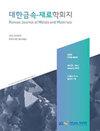n型Mg<sub>3</sub>SbBi<sub>0.99</sub>Te<sub>0.01</sub>热电材料
IF 1.1
4区 材料科学
Q4 MATERIALS SCIENCE, MULTIDISCIPLINARY
引用次数: 0
摘要
mg3sb2基材料有望取代n型Bi2Te3用于低温冷却和发电。一般来说,材料的热电性能受合成工艺参数的影响比较敏感,其中烧结温度(<i>Ts</i>)是一个关键温度。本研究采用机械合金化和放电等离子烧结(SPS)法制备了n型Mg3SbBi0.99Te0.01多晶样品,研究了不同的<i>Ts</i>研究了923 ~ 1073 K温度对热电性能的影响。在1073 K的高温下烧结Mg3SbBi0.99Te0.01,在423 K以下的低温下电导率显著提高。这归因于离子化杂质对载流子散射的急剧减少。由于同样的原因,载流子迁移率在a <i>Ts</i>1073 K,这是本研究烧结的临界温度。通过提高<i>Ts</i>, Seebeck系数增大,导热系数降低,导致1073 K烧结试样的最大功率因数(<i>PFmax</i>)为2.2 × 10-3 W m-1K-2,最大无因次优值(<i>zTmax</i>)为1.20。因此,当<i>Ts</i>从923 K提高到1073 K, PFmax</i>和& lt; i> zTmax< / i>分别增长29%和64%。这种性能的提高是由于消除了机械合金化过程中产生的缺陷,透射电子显微镜(TEM)的微观结构分析证实了这一点。本文章由计算机程序翻译,如有差异,请以英文原文为准。
Optimization of Sintering Temperature for the Synthesis of n-type Mg<sub>3</sub>SbBi<sub>0.99</sub>Te<sub>0.01</sub> Thermoelectric Materials
Mg3Sb2-based materials are promising candidates to replace n-type Bi2Te3 for cooling and power generation at low temperatures. Generally, the thermoelectric performance of a material is sensitively affected by synthesis process parameters, and among them, sintering temperature (Ts) is a critical one. In this study, n-type Mg3SbBi0.99Te0.01 polycrystalline samples were fabricated by mechanical alloying and spark plasma sintering (SPS), and the effects of varying Ts (923 – 1073 K) on the thermoelectric properties were investigated. Sintering Mg3SbBi0.99Te0.01 at an elevated temperature of 1073 K resulted in a notable increase in electrical conductivity at low temperatures below about 423 K. This is ascribed to a sharp reduction in carrier scattering by ionized impurities. For the same reason, the carrier mobility increased sharply at a Ts of 1073 K, which is a critical temperature for sintering in this study. Moreover, the Seebeck coefficient increased and thermal conductivity decreased simultaneously by raising Ts, resulting in the maximum power factor (PFmax) of 2.2 × 10-3 W m-1K-2 and the maximum dimensionless figure of merit (zTmax) of 1.20 in the sample sintered at 1073 K. Therefore, when Ts was raised from 923 K to 1073 K, the PFmax and zTmax increased by 29 % and 64 %, respectively. This improvement in performance is attributed to the annihilation of defects generated during the mechanical alloying process, which was confirmed by microstructure analysis by transmission electron microscopy (TEM).
求助全文
通过发布文献求助,成功后即可免费获取论文全文。
去求助
来源期刊

Korean Journal of Metals and Materials
MATERIALS SCIENCE, MULTIDISCIPLINARY-METALLURGY & METALLURGICAL ENGINEERING
CiteScore
1.80
自引率
58.30%
发文量
100
审稿时长
4-8 weeks
期刊介绍:
The Korean Journal of Metals and Materials is a representative Korean-language journal of the Korean Institute of Metals and Materials (KIM); it publishes domestic and foreign academic papers related to metals and materials, in abroad range of fields from metals and materials to nano-materials, biomaterials, functional materials, energy materials, and new materials, and its official ISO designation is Korean J. Met. Mater.
 求助内容:
求助内容: 应助结果提醒方式:
应助结果提醒方式:


